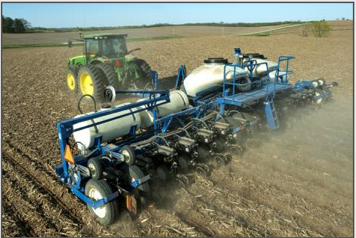Case Planters Setting Agronomic Standards for Planting Efficiency
While Deere focuses seed planters primarily on automation, precise seed location and distribution, and exacting pre and post planting soil manipulation, Case focuses on producing the highest yields on each planted seed. Though this may seem like a small difference in company design philosophy, the result shows up loud and clear when looking at the way each planter performs.
Deere Seed Planters – Bigger, Faster
Deere goes bigger, faster, and more controlled in planter designs. Deere holds the title to the largest planter available, the DB series, with 1000 acre per hour planting capability. Case does not even compete in that arena for the most part. Case planters are not after planting more acres per hour generally, but making sure each of the seeds planted produce, and produce high yields. This shifts designs from bigger, faster and more controlled, to gentler seed handling, more developed soil manipulation, and on planter fertilizer systems for improving germination rates.
Deere brings 48 rows of planting heads to Case’s 36 rows. That 30% increase for the Deere planter places a burden on Case’s germination rates and ground covering ability. Both planters have precise placement capabilities, but Case offers much higher towing efficiency resulting in less fuel costs for planting. Pulling 48 rows of planter heads will stress almost any tractor and push fuel consumption higher, compared to Case’s best in class towing weight of around 3000 pounds for their 36 row planter.
Case Seed Planters Claiming Earlier Rising
Case claims that the Early Riser planting system handles the entire seed planting process so much better than competing planters that the seeds will rise 1-3 days earlier than plantings from company’s like Deere, Agco, etc. Part of the reason for this claim comes from the gentler treatment of the soil. Case uses floating heads to allow the lighter planter to compress the soil less, allowing seeds to have an easier time for sprouting.
Case does not go to the same lengths as Deere with seed planter automation. Instead, Early Riser planters used a variety of soft touch systems, lighter designs, more maneuverable mechanics, and precise seed placement systems working together to get the ideal seed to soil preparation. This translates into farmers having to plant less and get the same total yield. Though Case planters promise higher yields and faster growth, the main advantage may be that Case planters are among the lightest in the industry and require less fuel for planting. Considering the steep diesel costs, yield may not even be the driving factor for investing in new planters from Case.
Case Planters Have the Lead in Yield
Key features for Case planters that make them superior for seed germination include:
-Using a seed conveyor instead of a seed disk. This eliminates disk changes and allows for exact seed deposits.
-Folding soil over the seed and creating a seed trench opening for early germination. By folding moist soil over the seed, it gives the seed a good environment for growth, while the trench allows for easier sprouting.
-A narrow 10.5 degree offset openers versus 14 degree nose to nose disk opener that cuts through soil residue more easily without destroying the soil environment.
Case has chosen yield over speed. Deere has chosen speed over yield. Both companies provide top notch planters, but now a farmer can decide which feature is more important to them and pick a planter accordingly.
At TractorExport, we will provide the best agricultural implement for each product, regardless of the brand.



